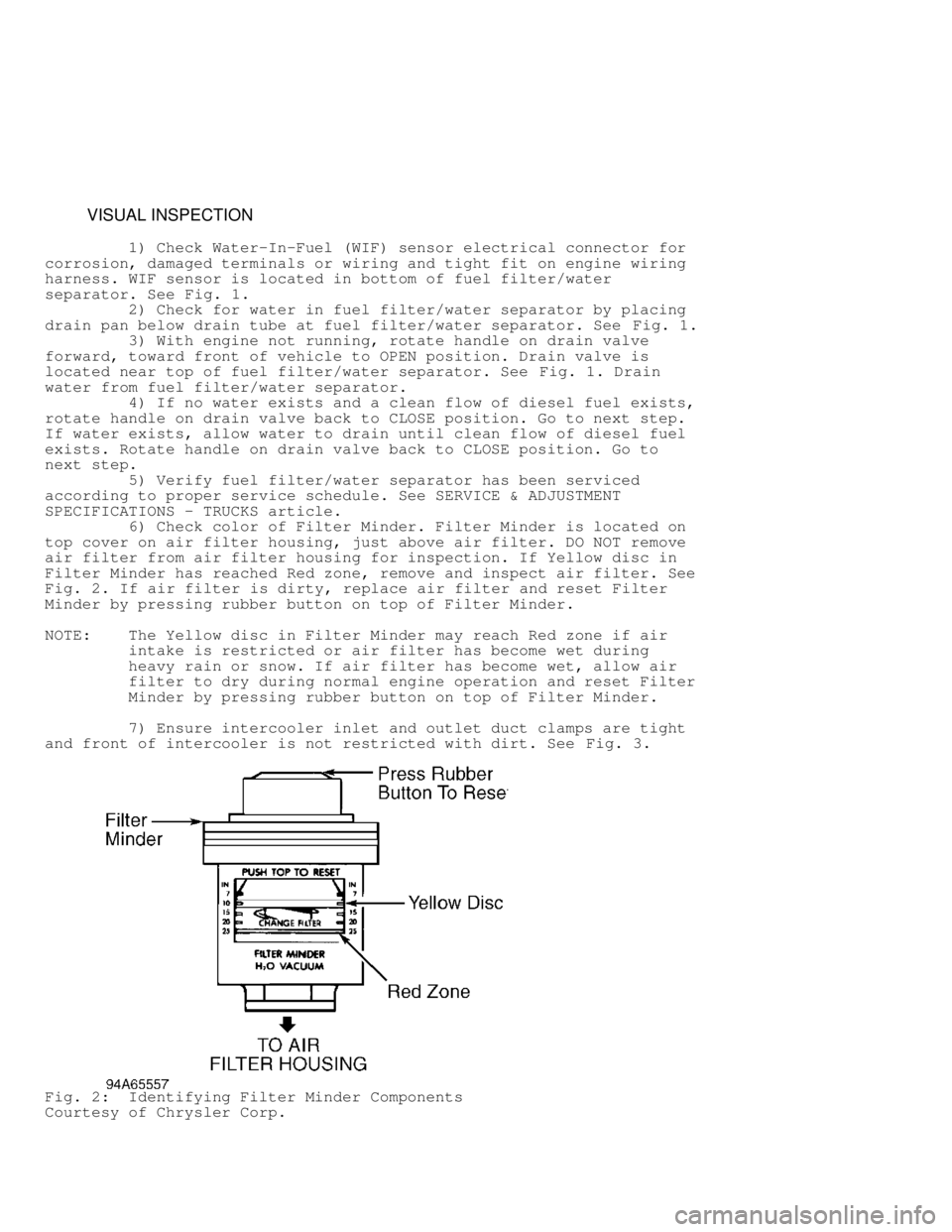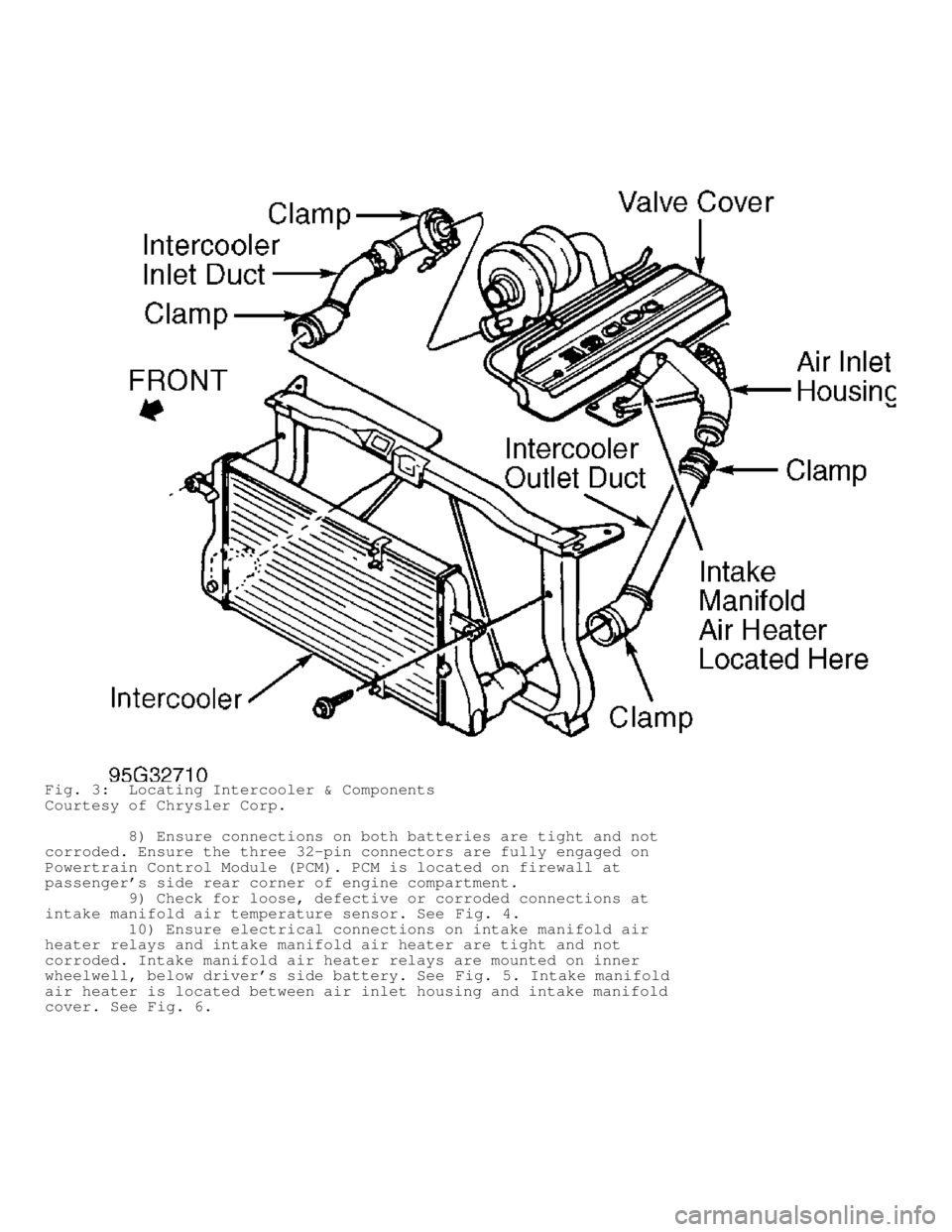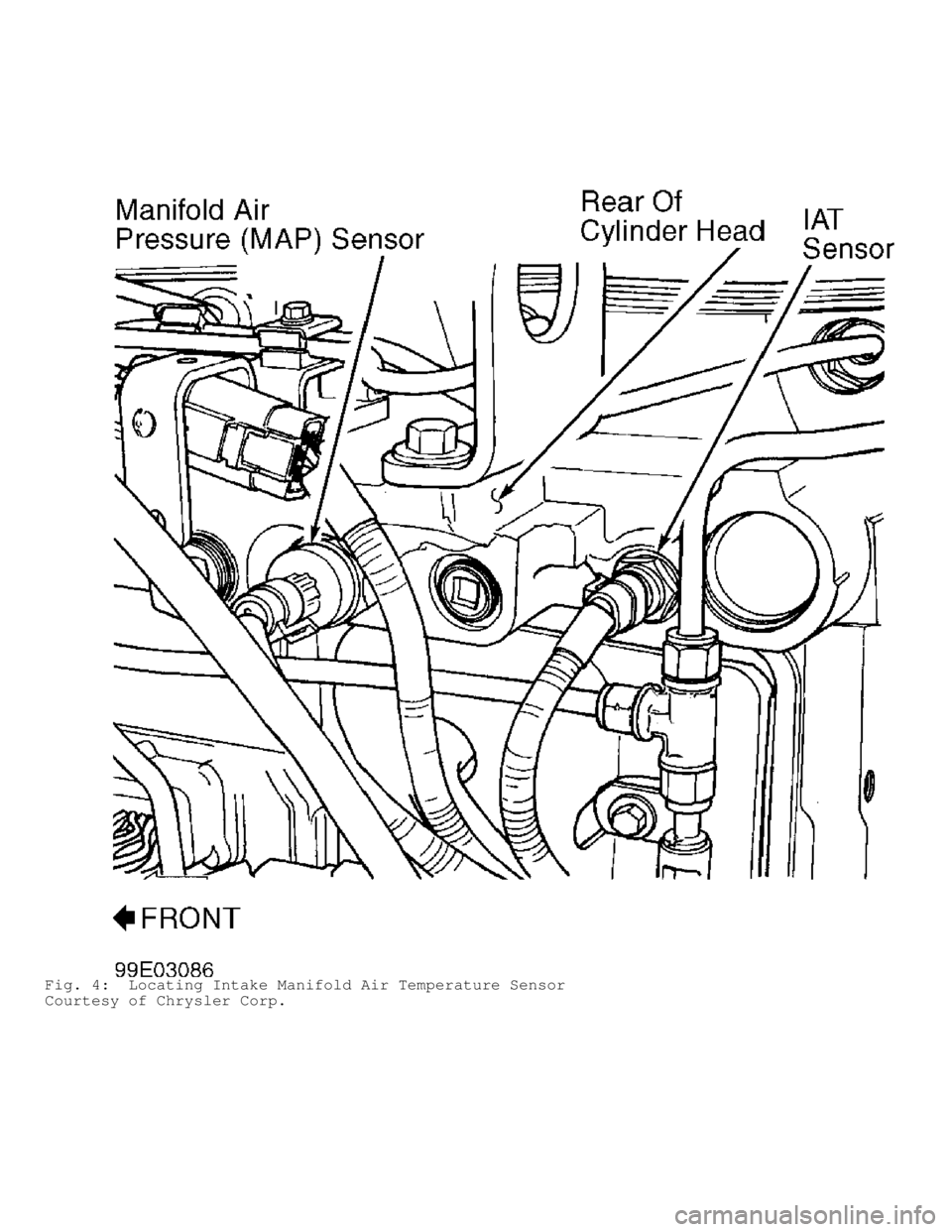1999 DODGE RAM sensor
[x] Cancel search: sensorPage 272 of 1691

OUTPUT SHAFT SPEED SENSOR
NOTE: Transmission output shaft speed sensor may also be referred
to as transmission shaft speed sensor or shaft speed sensor.
Removal & Installation
1) Disconnect electrical connector from output shaft speed
sensor, located on case of overdrive unit. Remove output shaft speed
sensor with "O" ring.
2) To install, reverse removal procedure using NEW "O" ring.
Tighten output shaft speed sensor to specification.
WIRING DIAGRAMS
Page 283 of 1691

VISUAL INSPECTION
1) Check Water-In-Fuel (WIF) sensor electrical connector for\
corrosion, damaged terminals or wiring and tight fit on engine wiring
harness. WIF sensor is located in bottom of fuel filter/water
separator. See Fig. 1.
2) Check for water in fuel filter/water separator by placing
drain pan below drain tube at fuel filter/water separator. See Fig. 1.
3) With engine not running, rotate handle on drain valve
forward, toward front of vehicle to OPEN position. Drain valve is
located near top of fuel filter/water separator. See Fig. 1. Drain
water from fuel filter/water separator.
4) If no water exists and a clean flow of diesel fuel exists,
rotate handle on drain valve back to CLOSE position. Go to next step.
If water exists, allow water to drain until clean flow of diesel fuel
exists. Rotate handle on drain valve back to CLOSE position. Go to
next step.
5) Verify fuel filter/water separator has been serviced
according to proper service schedule. See SERVICE & ADJUSTMENT
SPECIFICATIONS - TRUCKS article.
6) Check color of Filter Minder. Filter Minder is located on
top cover on air filter housing, just above air filter. DO NOT remove
air filter from air filter housing for inspection. If Yellow disc in
Filter Minder has reached Red zone, remove and inspect air filter. See
Fig. 2 . If air filter is dirty, replace air filter and reset Filter
Minder by pressing rubber button on top of Filter Minder.
NOTE: The Yellow disc in Filter Minder may reach Red zone if air
intake is restricted or air filter has become wet during
heavy rain or snow. If air filter has become wet, allow air
filter to dry during normal engine operation and reset Filter
Minder by pressing rubber button on top of Filter Minder.
7) Ensure intercooler inlet and outlet duct clamps are tight
and front of intercooler is not restricted with dirt. See Fig. 3.
Fig. 2: Identifying Filter Minder Components
Courtesy of Chrysler Corp.
Page 284 of 1691

Fig. 3: Locating Intercooler & Components
Courtesy of Chrysler Corp.
8) Ensure connections on both batteries are tight and not
corroded. Ensure the three 32-pin connectors are fully engaged on
Powertrain Control Module (PCM). PCM is located on firewall at
passenger's side rear corner of engine compartment.
9) Check for loose, defective or corroded connections at
intake manifold air temperature sensor. See Fig. 4.
10) Ensure electrical connections on intake manifold air
heater relays and intake manifold air heater are tight and not
corroded. Intake manifold air heater relays are mounted on inner
wheelwell, below driver's side battery. See Fig. 5. Intake manifold
air heater is located between air inlet housing and intake manifold
cover. See Fig. 6.
Page 285 of 1691

Fig. 4: Locating Intake Manifold Air Temperature Sensor
Courtesy of Chrysler Corp.
Page 287 of 1691

Fig. 6: Locating Intake Manifold Air Heater
Courtesy of Chrysler Corp.
NOTE: Restricted low-pressure fuel lines from fuel tank to fuel
transfer pump, fuel heater and fuel filter/water separator
may cause starting problems and prevent engine from
accelerating. Restricted high-pressure fuel lines from fuel
injection pump to fuel injector may cause starting problems,
poor engine performance and excessive Black smoke.
11) Check all fuel supply and returns lines for damage,
kinking or leakage. Check throttle linkage for binding. Check for a
stretched or disconnected throttle return spring.
12) Ensure all ground connections are tight and free of
corrosion. Ensure accessory drive belt is not damaged or slipping.
Check for loose or defective electrical connection on Crankshaft
Position (CKP) sensor. See Fig. 1.
Page 288 of 1691

13) On A/T models, ensure all electrical connectors are clean
and properly connected to electrical plugs on transmission case. On
all models, check for loose or defective electrical connections on
starter and starter solenoid.
MECHANICAL INSPECTION
Compression
Manufacturer does not provide information for checking
compression.
FUEL SYSTEM
AIR IN FUEL SYSTEM
NOTE: Air in the fuel system may cause hard starting, rough
running, excessive smoke, poor engine performance, engine
misfire, poor fuel economy and fuel knock. Air may enter fuel
system whenever fuel supply lines, fuel filter/water
separator, fuel injection pump, fuel injectors or high
-pressure fuel lines are removed or disconnected.
1) Inspect all low-pressure fuel lines from fuel tank to fuel
transfer pump, fuel heater and fuel filter/water separator for signs
of leakage. Inspect all high-pressure fuel lines for signs of leakage.
See FUEL INJECTOR & HIGH-PRESSURE FUEL LINES under FUEL SYSTEM.
2) After repairing fuel leak, bleed air from fuel system. See
FUEL LINE BLEEDING under FUEL SYSTEM in REMOVAL, OVERHAUL &
INSTALLATION - TRUCKS - DIESEL article.
FUEL HEATER
1) Fuel heater is located in fuel filter/water separator. See
Fig. 1 . Fuel heater uses a fuel heater temperature sensor for
controlling operation of the fuel heater.
2) A defective fuel heater may cause excessive wax build-up
in the fuel filter/water separator during cold ambient temperatures.
Wax build-up may cause hard starting, prevent engine from
accelerating, low power, Blue smoke or White smoke. For testing of
fuel heater and fuel heater temperature sensor, see SYSTEM & COMPONENT
TESTING - TRUCKS - DIESEL article.
FUEL HEATER RELAY
Ensure fuel heater relay, located in power distribution
center is installed correctly and that terminals are not corroded. For
fuel heater relay testing, see SYSTEM & COMPONENT TESTING - TRUCKS -
DIESEL article.
FUEL FILTER/WATER SEPARATOR
NOTE: A blocked or restricted fuel filter/water separator may cause
starting problems, prevent engine from accelerating, low
power or White smoke. If an excessive amount of water
collects in filter/separator in a short period of time, it
may be necessary to drain and clean fuel tank.
1) When ignition switch is first turned to ON position,
WATER-IN-FUEL (WIF) warning light should come on for 2 seconds to
perform bulb and wiring circuit test and then go off. WATER-IN-FUEL
(WIF) warning light is located on instrument panel, just below the
Page 291 of 1691

NOTE: A leaking fuel injector or high-pressure fuel line may cause
a rough idle, Black smoke, poor engine performance, poor fuel
economy and fuel knock. Since a leaking high-pressure fuel
line may cause the same symptoms, check for leaking high
-pressure fuel line before checking fuel injector.
1) To determine which injector or line is malfuntioning,
start engine and check each cylinder output using scan tool. If scan
tool is not available, start engine and engine allow to idle. Loosen
high-pressure fuel line nut at each fuel injector in turn and listen
for a decrease in engine speed. Tighten high-pressure fuel line nut to
30 ft. lbs. (40 N.m). Go to next step.
2) To check for a leaking high-pressure fuel line, start
engine and allow engine to idle. Inspect high-pressure fuel lines and
connections for signs of fuel leakage by placing cardboard over high-
pressure fuel line and connection. Note if leak is being detected by
fuel being sprayed onto the cardboard. If leak exists, repair leak by
tightening high-pressure fuel line nut to 30 ft. lbs. (40 N.m) or
replacing high-pressure fuel line as necessary. If high-pressure fuel
line is replaced, bleed air from fuel system. See FUEL LINE BLEEDING
under FUEL SYSTEM in REMOVAL, OVERHAUL & INSTALLATION - TRUCKS -
DIESEL article. If no leaks are found, go to next step.
3) Remove suspect injector. See FUEL INJECTOR under FUEL
SYSTEM in REMOVAL, OVERHAUL & INSTALLATION - TRUCKS - DIESEL article.
Test injector with a diesel fuel injector tester. Follow tester
instructions. Replace fuel injector if fuel injector opening (pop)
pressure is not 4250-4750 psi (299-334 kg/cm
�). Replace injector if
any leaks are noted at 291 psi (20 kg/cm�) less than opening (pop)
pressure. Inspect injector for burrs, cracks, wear and plugging. Check
spray pattern. If any problems are noted, replace injector.
FUEL INJECTION PUMP TIMING
Improper fuel injection pump timing may result in low power,
excessive smoke and poor fuel economy. To check fuel injection pump
timing, see FUEL INJECTION PUMP TIMING in ADJUSTMENTS - TRUCKS -
DIESEL article.
INTAKE MANIFOLD AIR HEATER
NOTE: Intake manifold air heater is used to heat incoming air
before entering each cylinder. Warming of incoming air aids
in engine starting and improved driveability during cold
ambient temperatures. Engine Control Module (ECM) uses input
signals from various sensors for controlling intake manifold
air heater relays.
SUMMARY
If no faults were found while performing basic diagnostic
procedures, proceed to SELF-DIAGNOSTICS - JEEP, TRUCKS & RWD VANS
article. If no diagnostic trouble codes are found in self-diagnostics,
proceed to TROUBLE SHOOTING - NO CODES - DIESEL article for diagnosis
by symptom (i.e., ROUGH IDLE, NO START, etc.) or intermittent
diagnostic procedures.
Page 298 of 1691

* ONE GAUGE NOT OPERATING PROPERLY
OVERHEAD CONSOLE CONCERNS
* AVERAGE MPH/FUEL ECON INOPERATIVE OR WRONG (CMTC FAILS TO
RESPOND TO INSTRUMENT CLUSTER DIMMING, DISTANCE TO EMPTY
INOPERATIVE OR WRONG, ELAPSED TIME INOPERATIVE/WRONG, SWITCH
ON CMTC INOPERATIVE, TRIP ODOMETER INOPERATIVE/WRONG)
* CMTC DISPLAY SHOWS FAILED
* CMTC SEGMENTS FAIL TO LIGHT UP
* INCORRECT READING BEYOND +/- 5
* REPAIRING "OC" IN CMTC DISPLAY
* REPAIRING "SC" IN CMTC DISPLAY
POWER DOOR LOCK SYSTEM
* DOOR LOCK SWITCH FAILURE (PDL)
* DOOR UNLOCK SWITCH FAILURE (PDL)
* AUTOMATIC (ROLLING) DOOR LOCKS INOPERATIVE
* DOORS LOCK WITH KEY IN IGNITION & LEFT DOOR OPEN
* ONE OR ALL DOORS FAILING TO LOCK FROM ONE SWITCH (ONE OR ALL
DOORS FAILING TO UNLOCK FROM ONE SWITCH)
* REMOTE KEYLESS ENTRY PROBLEM
VEHICLE THEFT/SECURITY SYSTEM
* DOOR DISARM SWITCH FAILURE
* DOOR LOCK SWITCH FAILURE
* DOOR UNLOCK SWITCH FAILURE
* EEPROM CHECKSUM FAILURE
* INTERNAL ROM TEST FAILURE
* IDENTIFYING VTSS PROBLEMS
WINDSHIELD WIPER SYSTEM
* WIPER PARK SWITCH FAILURE
* INTERMITTENT WIPERS INOPERATIVE
* NO WIPER ACTUATION AFTER WASH BUTTON PUSHED
* WIPER SPEED SENSITIVE FEATURE INOPERATIVE
CHIME SYSTEM
CHIME INOPERATIVE WITH EXTREME COOLANT TEMPERATURE
NOTE: For connector terminal identification and wiring diagrams,
see BODY CONTROL COMPUTER - INTRODUCTION article. Perform
VERIFICATION TEST VER-1A after each repair.
CAUTION: Always turn ignition switch to OFF position prior to
disconnecting any module connector.
1) Using scan tool, actuate chime. If chime sounds, go to
next step. If chime does not sound, replace Central Timer Module
(CTM). CTM is located under left side of instrument panel.
2) Using scan tool, read Powertrain Control Module (PCM)
DTCs. If no engine coolant temperature related codes exist, go to next
step. If engine coolant temperature related codes exist, see
appropriate SELF-DIAGNOSTICS article in ENGINE PERFORMANCE section.
3) Due to difficult access of coolant temperature sensor, Oil
Pressure Switch (OPS) will be used to verify CCD bus message from PCM.\
Disconnect OPS connector. OPS is located near bottom of distributor.